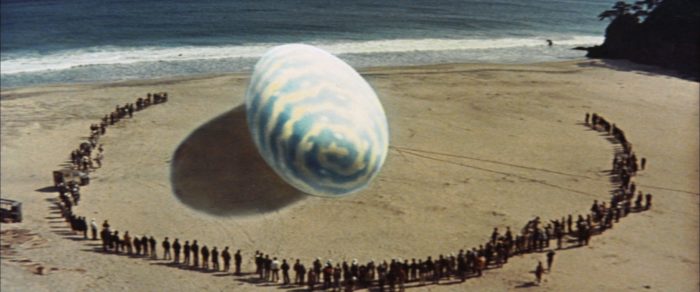
I honestly didn’t think I’d be stepping into the realm of the kaiju again so soon, but everything changed the day we watched Boiler Room on The Pick. The song that ends that particular early-2000s Ben Affleck movie is Pharoahe Monch’s “Simon Says”, something I definitely haven’t thought of in 20 years (which makes the lyrics “y’all know the name” feel ironic) but absolutely love for its big, phat, nasty hook. Unfortunately for Monch, it samples the theme to Mothra vs. Godzilla without Toho’s permission, which stopped distribution of Monch’s debut album. Fortunately for me, it was enough to get me to reopen my Godzilla box set, since I got to here those bold, brassy horns plenty of times during this movie.

So, where are we? It’s 1964 and this is the fourth Godzilla movie; following his debut in 1954, the king of the monsters has Raided Again in 1955, where he took on the ankylosaurus-like Anguirus, and fought a notably bigger King Kong in 1962, which brought the series into color and widescreen. All of those were directed by Ishirō Honda, who in that time also made more the 20 other movies including Rodan and the first Mothra. I haven’t seen that Mothra movie, but what I read of Wikipedia illuminated some key differences between this giant moth and big Zilla.
While Godzilla is just a prehistoric monster mutated by radiation, Mothra’s got a whole thing: she’s the guardian a presumed uninhabited island that was used for atomic tests called, of course, Infant Island. It actually is totally inhabited by dangerous exotic flora and fauna and isolated natives who worship Mothra and hey, doesn’t this sound a bit like King Kong? Don’t worry, it gets worse: there’s also two tiny “Shobijin,” 12-inch tall twin women who are kidnapped and brought to mainland Japan where an evil businessman profits by putting them in a show. Mothra comes to Tokyo, wrecks it, and is ultimately reunited with the Shobijin and leaves in peace.
So in summary, unlike Godzilla, Mothra:
- Has fans
- Only attacks Japan to protect her fans
- Is a big moth

Like so many of these movies, things start going bad when a big typhoon hits Japan. In Mothra vs. Godzilla, the storm destroys Kurata Beach, which brings reporter Saki (Akira Takarada) and photographer Junko (Yuriko Hoshi) just in time to see the discovery of a giant egg. The egg falls into the possession of evil businessman Kumayama (Yoshifumi Tajima), who, along with his financier Torahata (Yū Fujiki), intends to build an amusement park around it and exploit whatever hatches. Kumayama and Torahata are visited by the Shobijin who explain that the egg is Mothra’s and that they must return it. Seeing no profit in that, the money men instead try to capture the fairies who escape and end up finding Saki, Junko, and their concerned professor friend Miura (Hiroshi Koizumi), who try to help them by using the paper to turn public opinion against the exploitation of the egg. It doesn’t work, people are way to hyped to see that egg. Just then, Godzilla bursts out of the earth in Kurata and starts wrecking shit. So the trio and the Shobijin head to Infant Island to beg Mothra for help. But with mankind withholding her precious egg, will the divine insect deem us worth saving?
Mothra vs. Godzilla does have a message, although it’s a pretty basic one: the world is worth saving. Repeatedly, the characters argue that good people will die in Godzilla’s destruction along with the bad, and, more interestingly, “even bad people have a right to live.” Which it kinda undercuts by having the two human villains kill each other over a pile of money. But, you know, it’s nice. Quaint, but nice. Also it’s worth watching because Godzilla is fuckin’ unstoppable in this one my dudes. The Japanese Self Defense Force throw everything they’ve got at this big lizard and he shrugs it all of like it’s barely an inconvenience. There’s even a part when it looked to me like the actual Godzilla suit caught fire. It’s always humbling to think how much craftsmanship, hard work, and genuine suffering went in to making these movies fun.
